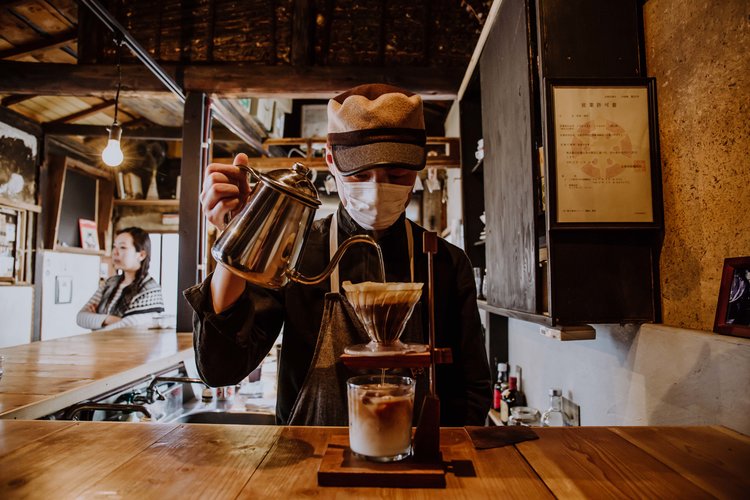How to mix espresso with beans, the soluble substances of artistic coffee.

Professional coffee knowledge exchange more coffee bean information please follow the coffee workshop (Wechat official account cafe_style)
It doesn't make any sense for the blending of espresso, or all coffee, to become a job that relies entirely on experience.
That's why you can hardly find anything about blending in almost all books about coffee.
Of course, there may be some introduction in the books of people who don't know anything about coffee blending, but I don't think it makes any sense.
The art of blending coffee beans
I understand why many bean bakers and baristas don't like matching, because the performance of matching is often disappointing.
You mix chocolate-flavored Brazilian beans with fruit-flavored Kenyan beans, and the baked beans are dry and sour. Why?
Aren't you supposed to get fruit chocolate flavor? This is not the case, unless you understand the soluble substance and its role in matching.
If you have ever tasted each bean in a match alone, then try this one again.
Then you may notice that the combination doesn't taste like each bean at all. In fact, it tastes more like a collection of all their shortcomings. This is because these coffees have different soluble substances.
A better roasting will make coffee beans contain more soluble substances. In other words, the development of better beans allows water to better permeate its structure.
Dissolve flavor substances. But the solubility is not only dissolved / insoluble. Each coffee also has some gray areas of solubility, which are different.
Imagine using Philharmonic pressure to make coffee, 6g coffee A with good solubility and 6g coffee B with less solubility. From the moment you add water
The two cups of coffee dissolve at different rates. Let's stop cooking at different times and see how it tastes.
2 minutes-Coffee A begins to be fully extracted and begins to produce delicious sweetness and round taste. B the extraction of coffee occurs very slowly
At this time, the extraction is still insufficient, in order to eliminate the sour taste, you continue to cook.
3 minutes-Coffee An is starting to taste a little overextracted; Coffee B is just getting its flavor highlighted and it takes more time to extract.
4 minutes-coffee An is overextracted, and finally, coffee B tastes great!
There is no time point in the cooking process at which both coffee beans reach the best flavor at the same time. As a barista, no matter how skillful you are, you can only make some choices when making this blended coffee. It is no exaggeration to say that there is nothing we can do about this coffee bean. The best you can do is to stop brewing between 2:30 and 3:00 so that neither coffee is seriously underextracted or overextracted.
If a bean baker doesn't match the solubility of the beans carefully, the match will never taste good.
And no one else can fix it. Once blended together, the soluble substances of all kinds of coffee will be extracted at different rates, and the flavor will be messy or abrupt.
When you adjust the proportion of each coffee bean in the mix, you are not adjusting the flavor intensity of each coffee bean. What you are actually adjusting is the extraction degree of different beans. This deserves serious consideration.
When the solubility of each bean in the match is very good, the taste of the match does not know how much better. It's the difference between day and night. When the match is not good, the match tastes like a mixed taste, that is, the mixed taste of insufficient extraction, sufficient extraction and excessive extraction. When matched properly, you can easily taste every coffee bean in the mix. The characteristics of each cup of coffee will not be weakened or obscured by others, they just live together in harmony. It's like magic!
If you are in the anti-match camp, maybe you can try again. Talk to your bean baker and learn a little about the solubility of each bean in the mix. Or ask him for some coffee beans in the mix to taste separately, and then try a different proportion.
END
Important Notice :
前街咖啡 FrontStreet Coffee has moved to new addredd:
FrontStreet Coffee Address: 315,Donghua East Road,GuangZhou
Tel:020 38364473
- Prev

Why do you make mixed coffee? not all mixed coffee tastes bad.
Professional coffee knowledge exchange more coffee bean information please follow the coffee workshop (Wechat official account cafe_style) this article will discuss blending. Why commercial cafes use blended coffee beans, and why some bakers choose to use blended beans, while others don't. Tell me why blending has a bad reputation in the boutique coffee industry. For a long time, coffee.
- Next

What kind of coffee beans are suitable for adding milk? Why do you want milk in your coffee? Can I have milk in my coffee?
Professional coffee knowledge exchange more coffee bean information Please pay attention to the coffee workshop (Wechat official account cafe_style) although black coffee is healthy and easy to taste, but there are still many people like to drink coffee with milk, silky rich milk flavor and coffee flavor multiply each other to add richness to the taste. But there are many kinds of coffee, and the common ones are coffee beans named after the countries or regions in which they are produced.
Related
- Beginners will see the "Coffee pull flower" guide!
- What is the difference between ice blog purified milk and ordinary milk coffee?
- Why is the Philippines the largest producer of crops in Liberia?
- For coffee extraction, should the fine powder be retained?
- How does extracted espresso fill pressed powder? How much strength does it take to press the powder?
- How to make jasmine cold extract coffee? Is the jasmine + latte good?
- Will this little toy really make the coffee taste better? How does Lily Drip affect coffee extraction?
- Will the action of slapping the filter cup also affect coffee extraction?
- What's the difference between powder-to-water ratio and powder-to-liquid ratio?
- What is the Ethiopian local species? What does it have to do with Heirloom native species?

